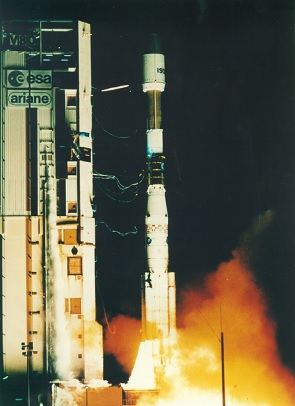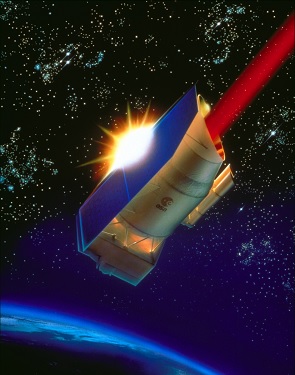ESA celebrates 25th anniversary of the Infrared Space Observatory with new data archive interface
17 November 2020
Today, ESA is celebrating the 25th anniversary of the launch of the Infrared Space Observatory, ISO, with a brand new interface to the mission's unique legacy archive. |
| Launch of ISO. Credit: ESA |
On 17 November 1995, an Ariane 44P launcher lifted off from the Guiana Space Centre near Kourou in French Guiana, carrying ESA's ISO satellite into orbit. ISO was the world's first true orbiting infrared space observatory, providing astronomers world-wide with unprecedented sensitivity and observation capabilities for a detailed exploration of the Universe at infrared wavelengths. Equipped with four state-of-the-art instruments, ISOCAM, ISOPHOT, SWS and LWS, ISO probed the sky in a range of optical, polarimetric and photometric modes from 2.5 to 240 microns, and with spatial resolutions ranging from 1.5 arcseconds (at the shortest wavelengths) to 90 arcseconds (at the longer wavelengths).
The mission was a great technical, operational and scientific success. Most satellite sub-systems operated far better than specifications and its scientific results impacted practically all fields of astronomy. The routine operational phase lasted until April 1998, almost a year longer than specified, during which time ISO made some 30 000 observations. The imaging, photometric, spectroscopic and polarimetric observations range from objects in our Solar System all the way out to the most distant extragalactic sources.
Among its scientific highlights, ISO detected the presence of water vapour throughout the Universe, including in star-forming regions, in the vicinity of stars at the end of their lives, in the atmospheres of planets in our Solar System and in the Orion Nebula. Several new molecules, such as hydrogen fluoride, were also discovered in space for the first time using ISO's sensitive instruments. ISO also discovered substantial amounts of cosmic dust in the vast empty space between galaxies, and was used to determine that the powerful source of infrared light in the nearest ultra-luminous infrared galaxy, Arp 220, is an outburst of star formation in that galaxy.
 |
| ISO spacecraft. Credit: ESA/ISO |
ISO's legacy archive
Today, on the occasion of ISO's 25th launch anniversary, ESA announces a brand new interface to the ISO data archive. The mission's complete data sets are now available through the faster, lighter, and user-friendly web interface at http://archives.esac.esa.int/nida.
With this release, the ISO data archive can now also be queried via various scripting and command-line options. These are described in the new interface's user manual, available from the same web interface. Among them is a sub-module in the popular astropy/astroquery module, available at the next astropy release. ISO's science observations continue to be accessible also via ESASky, ESA's portal to astronomy data, with an interactive all-sky interface and many features to search ISO data and compare them with data from the same region taken by other missions at other wavelengths.
"Even 25 years after its launch, data from ISO continue to be a major source of scientific discoveries," says ESA's Director of Science Günther Hasinger. "Providing state-of-the-art tools to access and use the valuable data from all our science missions, including the legacy missions, is part of ESA's strategy to support the continued advancements in science and our understanding of the Universe."
Access the new ISO Data Archive interface here.
For further information, please contact:
Bruno Merín
Head of the ESAC Science Data Centre
European Space Astronomy Centre (ESAC)
Villanueva de la Cañada, Spain
E-mail: Bruno.Merin![]() esa.int
esa.int


